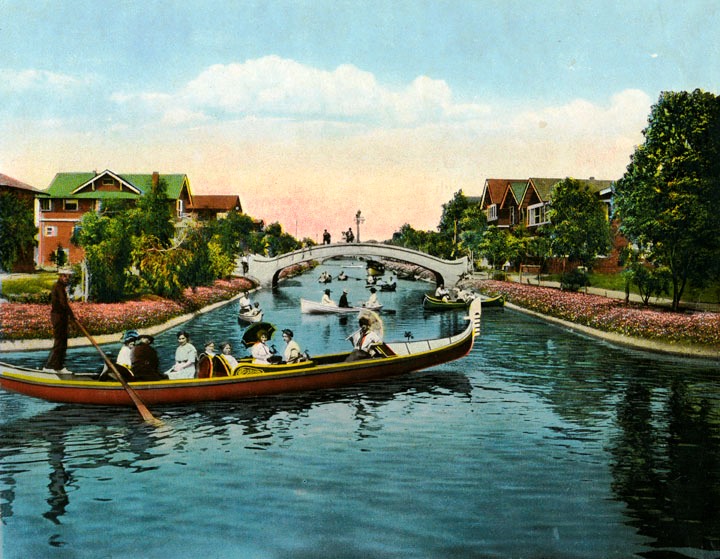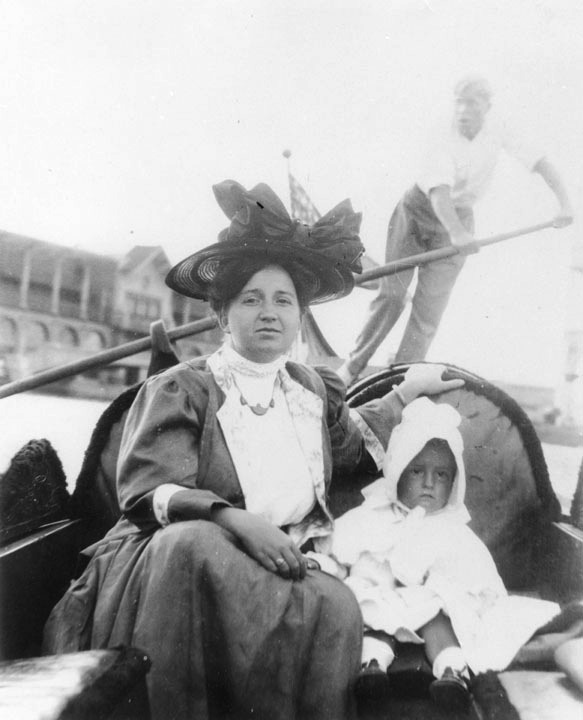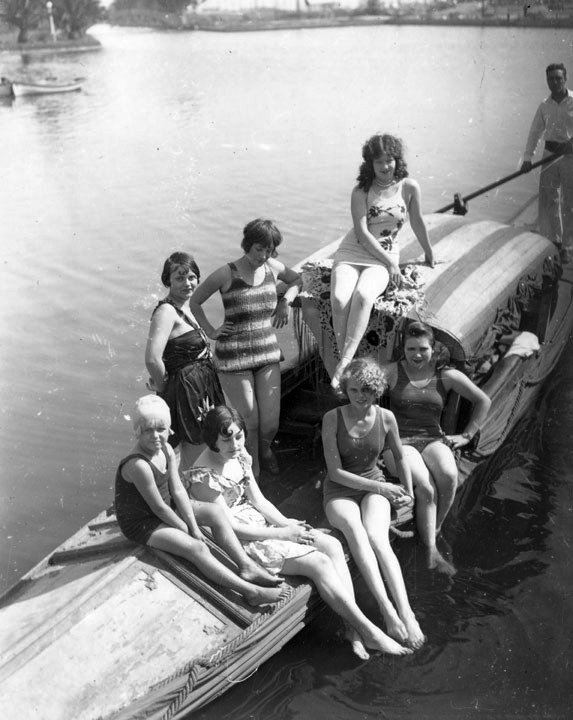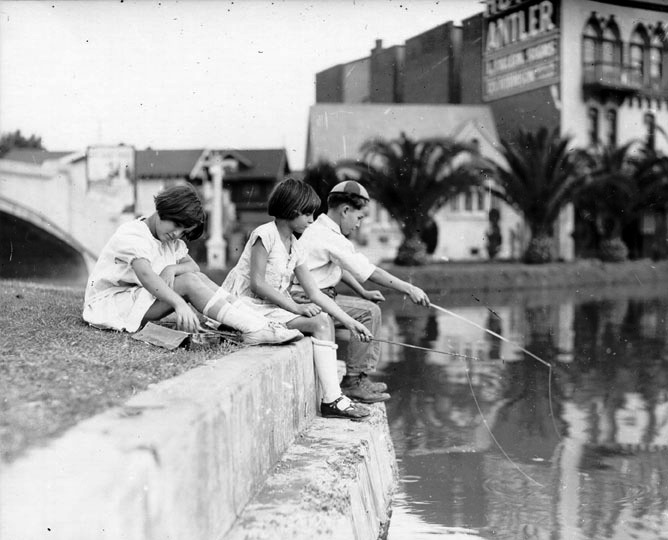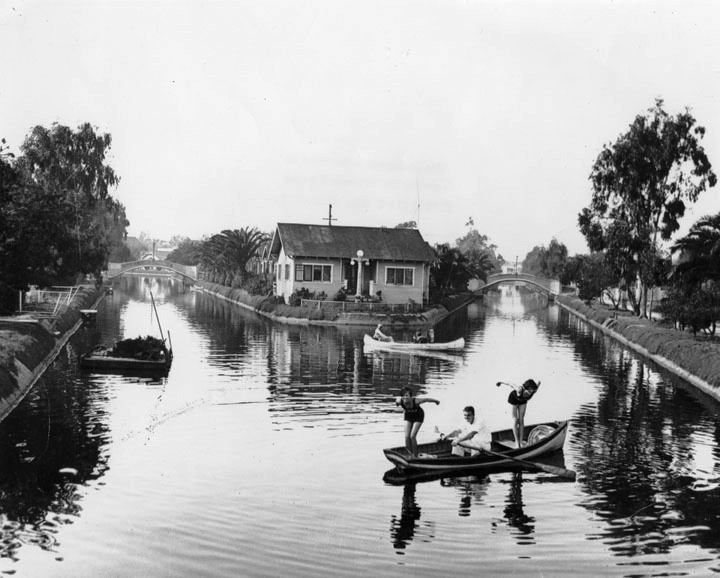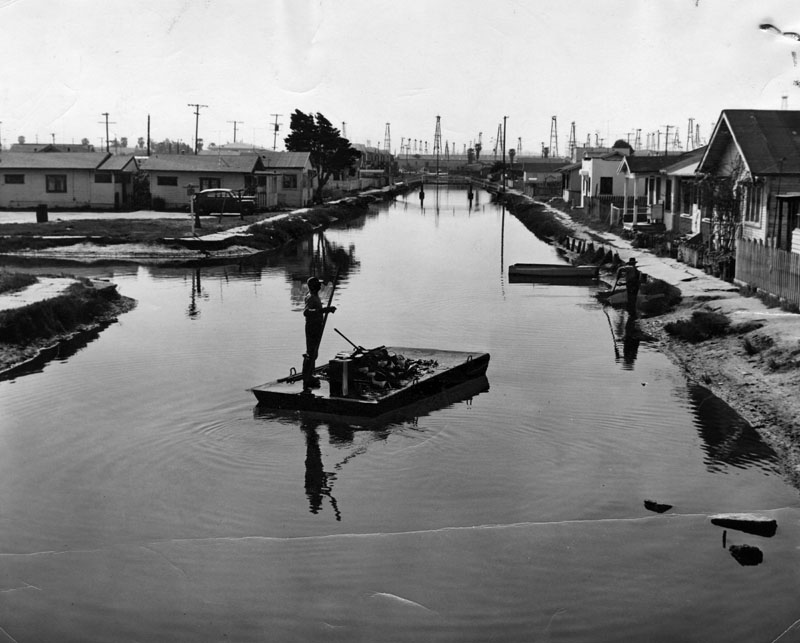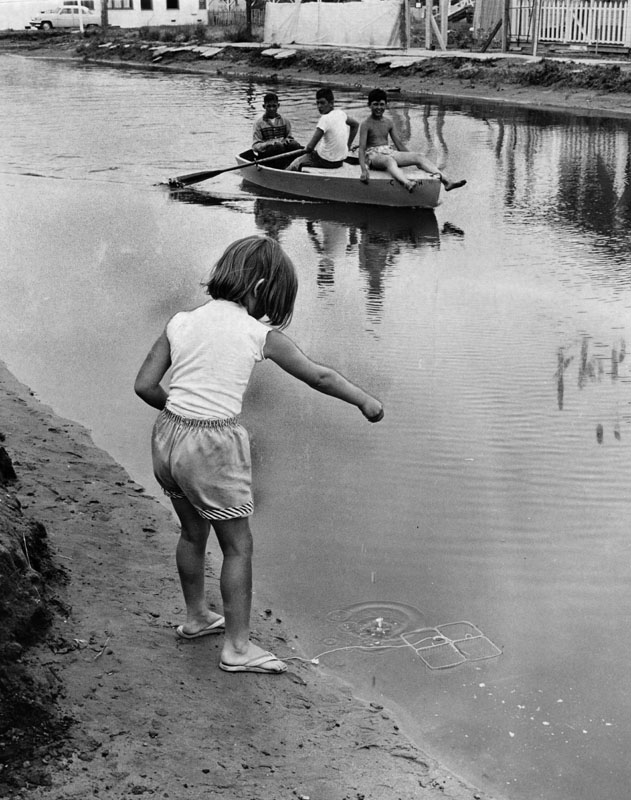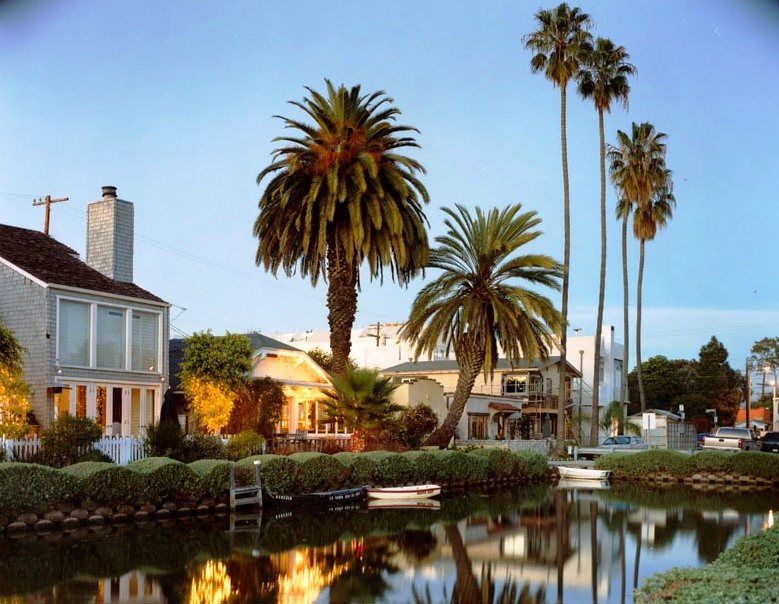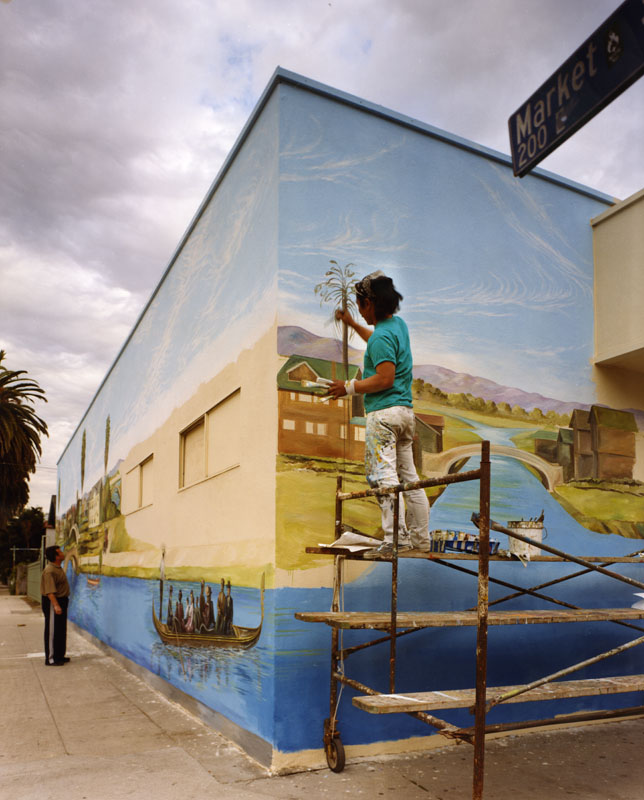Early last century a developer had a bright idea.
Those words might be written about many developers and many bright ideas. The wide swath of territory in the Southland, bounded by oceans and mountains, was fertile ground for those looking to make a name for themselves, or simply make a buck.
Our story is about one Abbot Kinney (1850-1920), a man who made a fortune in the tobacco business and ended up dying of lung cancer. In between, he put his name on the community of Venice, California. Like many of the bright ideas that abounded around greater Los Angeles, Kinney’s vision did not play out exactly as he had hoped; nonetheless it made its mark. Beginning in 1905 he and his heirs transformed a beach village, just south of Ocean Park/Santa Monica, into pleasure grounds styled after the great Italian water-bound city of Venice.
This essay is about the canals of Venice, so we won’t go into the the details of the many attractions the Kinneys installed in their theme-park like community — the pier with its roller coasters, games, and rides, the miniature railroad line used to tour prospective real estate buyers, the bath house, amphitheater, midway, circus and sideshow performers, exotic animals, beauty pageants, restaurants, hotels, and souvenir shops. Suffice it to say that Kinney succeeded in creating a carnival-like atmosphere that prevailed along the shore for four decades.
Digging of the canals gets underway with horses and mules, 1904. Herald-Examiner Collection, Image #00057203.
In laying out the community he called Venice-of-America, Kinney designed a network of interconnected canals filled with tidal water from the Pacific. Throughout history canals have been dug for many purposes — shipping and transportation, irrigation, and flood control. The Venice canals are examples of canals dug largely for aesthetic and recreation purposes. (The trenching did serve to drain the marshy land destined for building projects.) The promotional diagram below indicates seven named canals intersected by streets and all connected to each other. The largest of these was named the Grand Canal after the famed canal of Venice, Italy. The Grand Canal terminated in a lagoon (called a Bathing Lake in the image below).
Not shown here is another set of four named canals, closely parallel to each other, which were built a bit later by anther concern on the south side of town. The so-called Short Line Canals — a rectangle formed by the Carroll, Linnie, Howland, and Sherman Canals, bounded at the top by Eastern Canal and at the bottom by the Grand Canal, are what survive today as the Venice Canal Historic District. They were nicknamed for the Venice Short Line Railway which brought throngs of visitors to the coast.
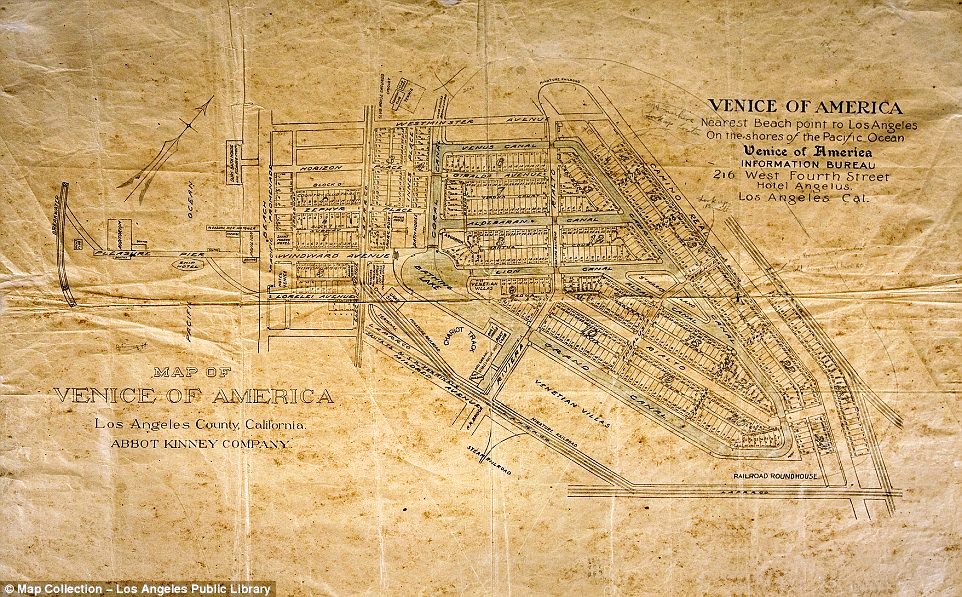
Kinney was keen to bring the Venetian spirit to Southern California. His canal system came complete with gondolas and singing gondoliers. Some say he imported the gondoliers directly from Italy, although in Los Angeles it seems likely he would have found many young men willing to play the part. His canals were spanned by a number of delicately arches bridges a la Venice, Italy.
A mother takes her well-swaddled child for a ride in a gondola on the Grand Canal. Shades of L.A. Collection, Image #00005810, circa 1907.
A colorized photo, probably a postcard, shows an idyllic scene on the canals of Venice, circa 1909. The canals were nicely landscaped with floral borders, walkways, and night lighting. Security Pacific National Bank Collection, Image #00009227.
Bathing beauties on a gondola. The same party can be seen in several images in the collection, recognizable by their bathing suits. One suspects the women may be part of a publicity campaign. Security Pacific National Bank Collection, Image #00009230. The photo is undated, but is likely from about 1920. The girl on top appears to take her hairstyle from actress Mary Pickford, “the girl with the curls.”
Aerial view of Venice Beach about 1925. The pier, rebuilt after a 1920 fire, featured not one, not two, but three elaborate roller-coasters. The lagoon and a portion of the canal system can be seen on the right hand side. Look for the arched bridges. Security Pacific National Bank Collection, Image #00009129.
This photo, dated approximately 1935, shows Venetian-style performers overlooking a muddy Grand Canal. The decline of the canal system is apparent from the broken timbers on what is clearly a rudimentary footbridge. Poor maintenance, the Great Depression, and the pressing needs of the automobile combined to doom the main section of canals. In 1929 the City of Los Angeles, which had annexed Venice four years earlier, paved over the original canals, leaving the Short Line Canals and a portion of the Grand Canal. Security Pacific National Bank Collection, Image #00009197.
Children fish in a canal on the edge of the Grand Lagoon, circa 1925. The Hotel Antler appears on the right . The Grand Lagooon was filled in about 1929. Security Pacific National Bank Collection, Image #00009222.
By the late-1920s, the gondolas were gone, but folks still found ways to have fun on the water. These canals are identified as Altair Canal on the left and Cabrillo Canal on the right, with “United States Island” between them, a development with rental bungalows each named for a state. Security Pacific National Bank Collection, Image #00009240.
By the time this photo of a garbage scow on the Grand Canal was taken in 1953, the waterways were not so grand. A forest of oil rigs has sprung up behind the the canals. Sidewalks were falling apart and the water was oily and polluted. Herald-Examiner Collection, Image #00057305.
This 1960 photo was taken for the Herald-Examiner for an article about sulfur fumes emanating from the canal. The canals have clearly lost much of their romantic appeal at this point. Herald-Examiner Collection, Image # 00057284.
Three “men” in a tub and a girl on shore find amusement in the decaying Grand Canal. Herald-Examiner Collection, Image #00057279, 1962. The newspaper mentioned that the “city dads” were hoping to make improvements to the canals.
The Short Line Canals spent most of four decades in a state of slow decline, despite a number of proposals to restore them. In the 1980s residents banded together to clean and improve the remaining canals. Here a group of neighbors pull trash from the canals. Herald-Examiner Collection, Image #00043234, 1985, Photographer, Mike Sergieff.
In the late 1980s restoration efforts gained traction with the support of Los Angeles Councilmember Ruth Galanter and others. In 1992 work began in earnest to dredge out the heavily-silted canals, replace the walls with eco-friendly materials, and rebuild the crumbling walkways. The result was to make the canal district a more desirable, and therefore higher-rent, neighborhood.
A view of Carroll Canal in 2003. The caption in our catalog speaks of the changes that had taken place along the canals in recent decades. According to the caption, the neighborhoods surrounding the remaining canals were “favored by beatniks and artists in the 1960s.” The photo above displays an eclectic mix of architectural styles, as small bungalows were remade to suit a more affluent population. Los Angeles Neighborhoods Collection, Image #00066952, July 17, 2003. Photographer, Cheryl Himmelstein.
Muralist David Legaspi III pays homage to the canals of Old Venice on the walls of the Ocean View Adult Day Health Care Center. Legaspi was a prolific artist whose murals appear all over the Southland. He passed away in 2012. Los Angeles Neighborhoods Collection, Image #00066969, February 7, 2003. Photographer, Cheryl Himmelstein.
We’ll close with a portrait of the man with the plan: Abbot Kinney. Security Pacific National Bank Collection, Image #00075783, undated.

